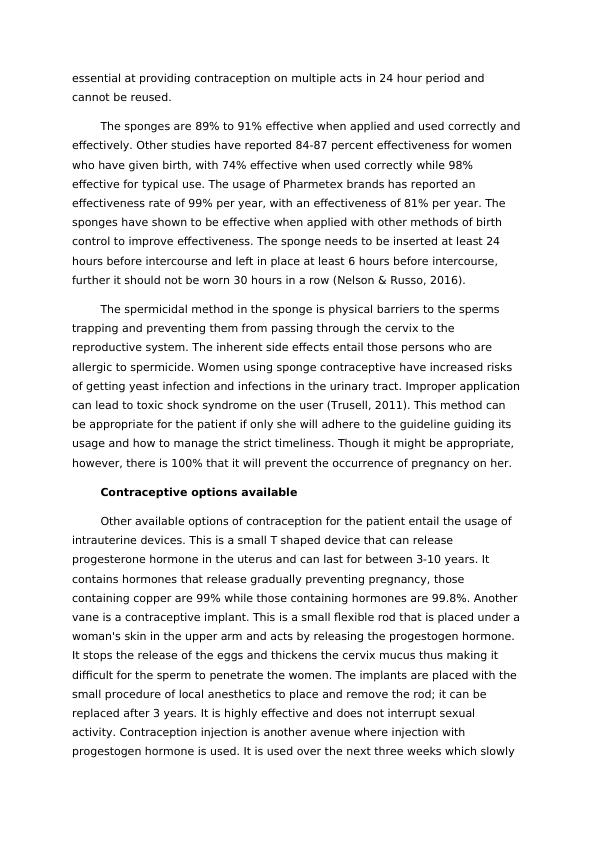Contraceptive Usage Analysis
Response to a patient's questions about contraception options.
7 Pages1878 Words19 Views
Added on 2022-08-27
Contraceptive Usage Analysis
Response to a patient's questions about contraception options.
Added on 2022-08-27
ShareRelated Documents
Contraceptive usage analysis
University
Task
Name
Unit
Date
University
Task
Name
Unit
Date

Usage of Pill option for the patient
Three types of oral contraceptive pills are available; combined estrogen-
progestogen, progestogen-only and extended pill use. The birth control pills are
the most widely issued US, with about 25% of women aged between 15-44 years
using. The most prescription being made is the combined hormonal pill having
progestogen and estrogens. Progestogen prevents the occurrence of pregnancy
while the estrogen is effective in controlling menstrual bleeding. Its effectiveness
depends on typical and perfect use. typical application refers to inconsistent use
which often leads to failure of about 9 out of 100 women while perfect use
implies correct and consistent usage (Maguire & Westhoff, 2011).
The underlying mechanisms of action entail pregnancy prevention, it
prohibits ovulation through the development of follicular and prevention of
ovulation (Tepper et al., 2016). Further, it can prevent sperm penetration into
the cervix and the upper genital altering the cervical mucus towards the sperms.
Despite these potential benefits for the patient, there are underlying
contraindications that are present. Women having uncontrolled hypertension
states are not advised to start oral contraceptive use. Further, smokers are also
contraindicated, especially those above 35 years due to the inherent risks of
cardiovascular-related complications such as deep vein thromboembolism. There
is an increased risk among pill users at about 3-9/10,000 occurrences compared
to those who are not using them at 1-5/10,000 cases. This risk is greater among
the person who is smoking and over 35 years. Further, persons such as the
patient having migraines coupled with auras are not supposed to use the pill
(Weerasinghe et al., 2017).
Thus with this inherent contraindication on the patient, it is not thus
advisable for her to use the pill option. Various aspects outline above are
hindering the patient and could have significant risks for her health.
Contraceptive sponge usage
Contraceptive sponge entails a combination of a barrier and a spermicidal
method for conception prevention. Sponge’s mechanism entails insertion into the
vagina to cover the cervix and prevent sperms from entering the uterus and
secondly it works by containing spermicide. The sponges are placed in the
vagina before intercourse and need to be placed in the cervix to be effective, it is
Three types of oral contraceptive pills are available; combined estrogen-
progestogen, progestogen-only and extended pill use. The birth control pills are
the most widely issued US, with about 25% of women aged between 15-44 years
using. The most prescription being made is the combined hormonal pill having
progestogen and estrogens. Progestogen prevents the occurrence of pregnancy
while the estrogen is effective in controlling menstrual bleeding. Its effectiveness
depends on typical and perfect use. typical application refers to inconsistent use
which often leads to failure of about 9 out of 100 women while perfect use
implies correct and consistent usage (Maguire & Westhoff, 2011).
The underlying mechanisms of action entail pregnancy prevention, it
prohibits ovulation through the development of follicular and prevention of
ovulation (Tepper et al., 2016). Further, it can prevent sperm penetration into
the cervix and the upper genital altering the cervical mucus towards the sperms.
Despite these potential benefits for the patient, there are underlying
contraindications that are present. Women having uncontrolled hypertension
states are not advised to start oral contraceptive use. Further, smokers are also
contraindicated, especially those above 35 years due to the inherent risks of
cardiovascular-related complications such as deep vein thromboembolism. There
is an increased risk among pill users at about 3-9/10,000 occurrences compared
to those who are not using them at 1-5/10,000 cases. This risk is greater among
the person who is smoking and over 35 years. Further, persons such as the
patient having migraines coupled with auras are not supposed to use the pill
(Weerasinghe et al., 2017).
Thus with this inherent contraindication on the patient, it is not thus
advisable for her to use the pill option. Various aspects outline above are
hindering the patient and could have significant risks for her health.
Contraceptive sponge usage
Contraceptive sponge entails a combination of a barrier and a spermicidal
method for conception prevention. Sponge’s mechanism entails insertion into the
vagina to cover the cervix and prevent sperms from entering the uterus and
secondly it works by containing spermicide. The sponges are placed in the
vagina before intercourse and need to be placed in the cervix to be effective, it is

essential at providing contraception on multiple acts in 24 hour period and
cannot be reused.
The sponges are 89% to 91% effective when applied and used correctly and
effectively. Other studies have reported 84-87 percent effectiveness for women
who have given birth, with 74% effective when used correctly while 98%
effective for typical use. The usage of Pharmetex brands has reported an
effectiveness rate of 99% per year, with an effectiveness of 81% per year. The
sponges have shown to be effective when applied with other methods of birth
control to improve effectiveness. The sponge needs to be inserted at least 24
hours before intercourse and left in place at least 6 hours before intercourse,
further it should not be worn 30 hours in a row (Nelson & Russo, 2016).
The spermicidal method in the sponge is physical barriers to the sperms
trapping and preventing them from passing through the cervix to the
reproductive system. The inherent side effects entail those persons who are
allergic to spermicide. Women using sponge contraceptive have increased risks
of getting yeast infection and infections in the urinary tract. Improper application
can lead to toxic shock syndrome on the user (Trusell, 2011). This method can
be appropriate for the patient if only she will adhere to the guideline guiding its
usage and how to manage the strict timeliness. Though it might be appropriate,
however, there is 100% that it will prevent the occurrence of pregnancy on her.
Contraceptive options available
Other available options of contraception for the patient entail the usage of
intrauterine devices. This is a small T shaped device that can release
progesterone hormone in the uterus and can last for between 3-10 years. It
contains hormones that release gradually preventing pregnancy, those
containing copper are 99% while those containing hormones are 99.8%. Another
vane is a contraceptive implant. This is a small flexible rod that is placed under a
woman's skin in the upper arm and acts by releasing the progestogen hormone.
It stops the release of the eggs and thickens the cervix mucus thus making it
difficult for the sperm to penetrate the women. The implants are placed with the
small procedure of local anesthetics to place and remove the rod; it can be
replaced after 3 years. It is highly effective and does not interrupt sexual
activity. Contraception injection is another avenue where injection with
progestogen hormone is used. It is used over the next three weeks which slowly
cannot be reused.
The sponges are 89% to 91% effective when applied and used correctly and
effectively. Other studies have reported 84-87 percent effectiveness for women
who have given birth, with 74% effective when used correctly while 98%
effective for typical use. The usage of Pharmetex brands has reported an
effectiveness rate of 99% per year, with an effectiveness of 81% per year. The
sponges have shown to be effective when applied with other methods of birth
control to improve effectiveness. The sponge needs to be inserted at least 24
hours before intercourse and left in place at least 6 hours before intercourse,
further it should not be worn 30 hours in a row (Nelson & Russo, 2016).
The spermicidal method in the sponge is physical barriers to the sperms
trapping and preventing them from passing through the cervix to the
reproductive system. The inherent side effects entail those persons who are
allergic to spermicide. Women using sponge contraceptive have increased risks
of getting yeast infection and infections in the urinary tract. Improper application
can lead to toxic shock syndrome on the user (Trusell, 2011). This method can
be appropriate for the patient if only she will adhere to the guideline guiding its
usage and how to manage the strict timeliness. Though it might be appropriate,
however, there is 100% that it will prevent the occurrence of pregnancy on her.
Contraceptive options available
Other available options of contraception for the patient entail the usage of
intrauterine devices. This is a small T shaped device that can release
progesterone hormone in the uterus and can last for between 3-10 years. It
contains hormones that release gradually preventing pregnancy, those
containing copper are 99% while those containing hormones are 99.8%. Another
vane is a contraceptive implant. This is a small flexible rod that is placed under a
woman's skin in the upper arm and acts by releasing the progestogen hormone.
It stops the release of the eggs and thickens the cervix mucus thus making it
difficult for the sperm to penetrate the women. The implants are placed with the
small procedure of local anesthetics to place and remove the rod; it can be
replaced after 3 years. It is highly effective and does not interrupt sexual
activity. Contraception injection is another avenue where injection with
progestogen hormone is used. It is used over the next three weeks which slowly

End of preview
Want to access all the pages? Upload your documents or become a member.
Related Documents
Contraception: Different Techniques and Riskslg...
|7
|1078
|152
Study On Reproduction - Methods Of Contraceptionlg...
|5
|537
|55
PHARM W8 RESPONSE 5 PHARM W8 RESPONSE Pharm w8 Response Name of the University Author Namelg...
|6
|1332
|481
Contraceptive Methods: Types, Effectiveness, and Usagelg...
|1
|541
|92
Pregnacy And Potential Complications Assignment 2022lg...
|5
|842
|14
